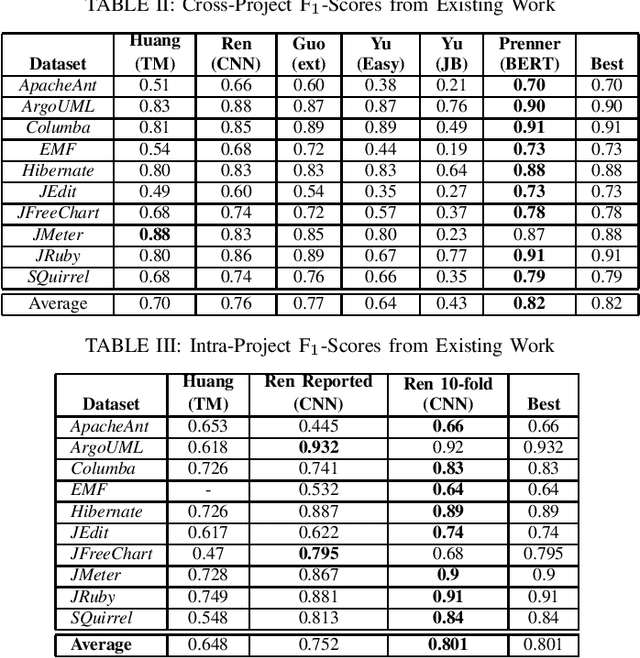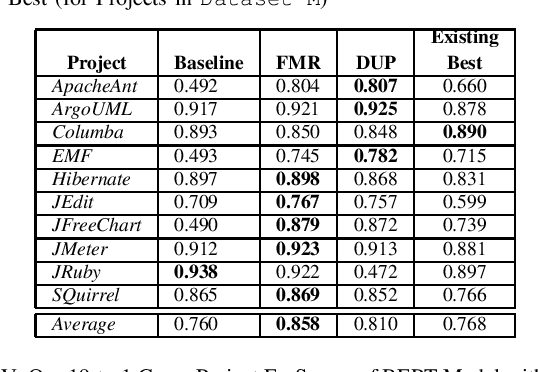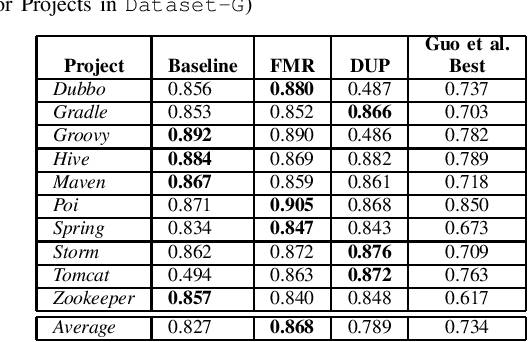William Aiken
Measuring Improvement of F$_1$-Scores in Detection of Self-Admitted Technical Debt
Mar 16, 2023



Abstract:Artificial Intelligence and Machine Learning have witnessed rapid, significant improvements in Natural Language Processing (NLP) tasks. Utilizing Deep Learning, researchers have taken advantage of repository comments in Software Engineering to produce accurate methods for detecting Self-Admitted Technical Debt (SATD) from 20 open-source Java projects' code. In this work, we improve SATD detection with a novel approach that leverages the Bidirectional Encoder Representations from Transformers (BERT) architecture. For comparison, we re-evaluated previous deep learning methods and applied stratified 10-fold cross-validation to report reliable F$_1$-scores. We examine our model in both cross-project and intra-project contexts. For each context, we use re-sampling and duplication as augmentation strategies to account for data imbalance. We find that our trained BERT model improves over the best performance of all previous methods in 19 of the 20 projects in cross-project scenarios. However, the data augmentation techniques were not sufficient to overcome the lack of data present in the intra-project scenarios, and existing methods still perform better. Future research will look into ways to diversify SATD datasets in order to maximize the latent power in large BERT models.
Neural Network Laundering: Removing Black-Box Backdoor Watermarks from Deep Neural Networks
Apr 22, 2020



Abstract:Creating a state-of-the-art deep-learning system requires vast amounts of data, expertise, and hardware, yet research into embedding copyright protection for neural networks has been limited. One of the main methods for achieving such protection involves relying on the susceptibility of neural networks to backdoor attacks, but the robustness of these tactics has been primarily evaluated against pruning, fine-tuning, and model inversion attacks. In this work, we propose a neural network "laundering" algorithm to remove black-box backdoor watermarks from neural networks even when the adversary has no prior knowledge of the structure of the watermark. We are able to effectively remove watermarks used for recent defense or copyright protection mechanisms while achieving test accuracies above 97% and 80% for both MNIST and CIFAR-10, respectively. For all backdoor watermarking methods addressed in this paper, we find that the robustness of the watermark is significantly weaker than the original claims. We also demonstrate the feasibility of our algorithm in more complex tasks as well as in more realistic scenarios where the adversary is able to carry out efficient laundering attacks using less than 1% of the original training set size, demonstrating that existing backdoor watermarks are not sufficient to reach their claims.
 Add to Chrome
Add to Chrome Add to Firefox
Add to Firefox Add to Edge
Add to Edge